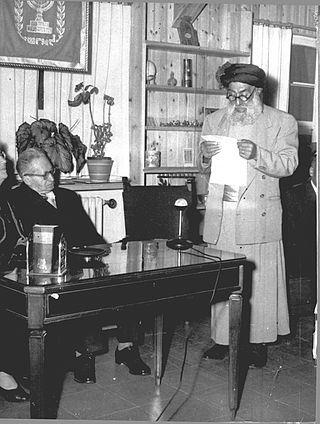 | |
| Author | Raphael Patai |
|---|---|
| Publisher | Scribner |
Publication date | 1977 |
The Jewish Mind is a non-fiction cultural psychology book by cultural anthropologist Raphael Patai first published in 1977.
 | |
| Author | Raphael Patai |
|---|---|
| Publisher | Scribner |
Publication date | 1977 |
The Jewish Mind is a non-fiction cultural psychology book by cultural anthropologist Raphael Patai first published in 1977.
Part I, "Preliminaries", lays the groundwork for the rest of the book. Part II, "Six Great Historic Encounters", reviews the formative and lasting influences on the Jewish mind of each period. In Part III, Patai analyzes the specific traits, characteristics and values shaping the Jewish mind during the prolonged and diverse Gentile exposure. [1]

A succubus is a female demon or supernatural entity in folklores who appears in dreams to seduce men, usually through sexual activity. According to some folklore, a succubus needs semen to survive; repeated sexual activity with a succubus will result in a bond being formed between the succubus and the person; and a succubus will drain or harm the man with whom she is having intercourse.
Benjamin Urrutia is an author and scholar. With Guy Davenport, Urrutia edited The Logia of Yeshua, which collected what Urrutia and Davenport consider to be Jesus' authentic sayings from a variety of canonical and non-canonical sources. Urrutia interprets Jesus' mission as a leadership role in the "Israelite nonviolent resistance to Roman oppression".

The Thirteenth Tribe is a 1976 book by Arthur Koestler advocating the Khazar hypothesis of Ashkenazi ancestry, the thesis that Ashkenazi Jews are not descended from the historical Israelites of antiquity, but from Khazars, a Turkic people. Koestler hypothesized that the Khazars migrated westwards into Eastern Europe in the 12th and 13th centuries when the Khazar Empire was collapsing.
Artephius is a writer to whom a number of alchemical texts are ascribed. Although the roots of the texts are unclear and the identity of their author obscure, at least some of them are Arabic in origin. He is named as the author of several books, the Ars sintrillia, Clavis sapientiae or Clavis maioris sapientiae, and Liber secretus.

Kurdish Jews are an Iranic ethnic group who follow the Jewish religion. Kurds come from the geographic region of Kurdistan, roughly covering parts of northwestern Iran, northern Iraq, northeastern Syria and southeastern Turkey.

Erich Brauer was a German Jewish illustrator, ethnographer, and ethnologist. As an artist he chose to be known as Erich Chiram Brauer. He often signed his art work "Chiram".
Naamah or Nahemoth is a demon described in the Zohar, a foundational work of Jewish mysticism. She originated from and is often conflated with another Naamah, sister to Tubal-cain.
Daphne Patai is an American scholar and author. She is professor emeritus of the Department of Languages, Literatures, and Cultures at the University of Massachusetts Amherst. Her PhD is in Brazilian literature, but her early work also focused on utopian and dystopian fiction. She is the daughter of the anthropologist Raphael Patai.
The Jews of Islam (1984) is a book written by Middle-East historian and scholar Bernard Lewis.
The Hebrew Goddess is a 1967 book by Jewish historian and anthropologist Raphael Patai, in which the author argues that historically, the Jewish religion had elements of polytheism, especially the worship of goddesses and a cult of the mother goddess.
Raphael Patai, born Ervin György Patai, was a Hungarian-Jewish ethnographer, historian, Orientalist and anthropologist.

The Yeshiva University Museum is a teaching museum and the cultural arm of Yeshiva University. Along with the American Jewish Historical Society, the American Sephardi Federation, the Leo Baeck Institute, New York, and the YIVO Institute for Jewish Research, it is a member organization of the Center for Jewish History, a Smithsonian Institution affiliate located in the Chelsea neighborhood of Manhattan.
The Arab Mind is a non-fiction cultural psychology book by Hungarian-born, Jewish cultural anthropologist and Orientalist Raphael Patai. He also wrote The Jewish Mind. The book advocates a tribal-group-survival explanation for the driving factors behind Arab culture. It was first published in 1973, and later revised in 1983. A 2007 reprint was further "updated with new demographic information about the Arab world".

In religious studies and folkloristics, folk religion, traditional religion, or vernacular religion comprises various forms and expressions of religion that are distinct from the official doctrines and practices of organized religion. The precise definition of folk religion varies among scholars. Sometimes also termed popular belief, it consists of ethnic or regional religious customs under the umbrella of a religion; but outside official doctrine and practices.
The February Revolution in Russia officially ended a centuries-old regime of antisemitism in the Russian Empire, legally abolishing the Pale of Settlement. However, the previous legacy of antisemitism was continued and furthered by the Soviet state, especially under Joseph Stalin. After 1948, antisemitism reached new heights in the Soviet Union, especially during the anti-cosmopolitan campaign, in which numerous Yiddish-writing poets, writers, painters and sculptors were arrested or killed. This campaign culminated in the so-called Doctors' plot, in which a group of doctors were subjected to a show trial for supposedly having plotted to assassinate Stalin. Although repression eased after Stalin's death, persecution of Jews would continue until the late 1980s.

Cousin marriage is a form of consanguinity. While consanguinity is not unique to the Arab or Islamic world, Arab countries have had "some of the highest rates of consanguineous marriages in the world". The bint 'amm marriage, or marriage with one's father's brother's daughter is especially common, especially in tribal and traditional Muslim communities, where men and women seldom meet potential spouses outside the extended family.
Chymes was a Greco-Roman alchemist who lived before the third century. He is known only through fragments of text in the works of Zosimos of Panopolis and Olympiodorus of Thebes.
Moses of Alexandria, often known simply as Moses or Moses the Alchemist, was an early alchemist who wrote Greek alchemical texts around the first or second century. He has also been called "Moses the thrice happy". The author of these alchemical texts was likely Jewish, since his writings show traces of Jewish monotheism and other Jewish beliefs.

Gerard Behar Center is a major arts centre in Jerusalem, Israel, for independent theatre, dance, and musical productions, children's shows, art exhibitions, artist workshops, and festivals. In 2010 the center hosted over 900 events with attendance in excess of 263,600 participants. The center includes two theatres and is home to two dance companies, Kolben and Vertigo.

Zakhor: Jewish History and Jewish Memory is a non-fiction work of Jewish historiography first published in 1982 by the historian Yosef Hayim Yerushalmi (1932–2009), a professor of Jewish history at Columbia University. It consists of four lectures that Yerushalmi gave as part of the 1980 series of "Stroum Lectures in Jewish Studies", now known as the Samuel and Althea Stroum Lectures in Jewish Studies, at the University of Washington in Seattle. Harold Bloom wrote the foreword for the publication. The title, Zakhor, is the Hebrew word for remember. The New Yorker described the book as "one of the most influential works on Jewish history" since the 1950s.